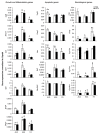Applicability of Hyaluronic Acid-Alginate Hydrogel and Ovarian Cells for In Vitro Development of Mouse Preantral Follicles
- PMID: 32779433
- PMCID: PMC7481901
- DOI: 10.22074/cellj.2020.6925
Applicability of Hyaluronic Acid-Alginate Hydrogel and Ovarian Cells for In Vitro Development of Mouse Preantral Follicles
Abstract
Objective: In the present study, the applicability of hyaluronic acid-alginate (HAA) hydrogel and ovarian cells (OCs) for the culture of mouse ovarian follicles were investigated and compared with those of alginate (ALG) and fibrin-alginate (FA) hydrogels.
Materials and methods: In the first step of this experimental study, mechanically isolated preantral follicles from the ovaries of two-week-old mice were encapsulated in the absence or presence of OCs in ALG, HAA, and FA hydrogels and cultured for 14 days. The morphology, diameter, survival and antrum formation rates of the follicles and the maturation and quality of the oocytes were evaluated during culture. In the second step, preantral follicles were cultured similar to the first step, but for 13 days, and their gene expressions and hormonal secretion were assessed on the last day of culture.
Results: In the absence of OCs, higher numbers of ALG- and HAA-encapsulated follicles reached the antral stage compared to FA-encapsulated follicles (P<0.05). However, a higher percentage of HAA-developed oocytes resumed meiosis up to the germinal vesicle breakdown (GVBD)/metaphase II (MII) stages in comparison with ALG-developed oocytes (P<0.05). HAA-encapsulated follicles had significant overexpression of most of the growth and differentiation genes, and secreted higher levels of estradiol (E2) compared to ALG- and FA-encapsulated follicles (P<0.05). The co-culture condition increased the diameter of ALG-encapsulated follicles on day 13 of culture (P<0.05). It also increased the survival and maturation rates of ALG- and FA-encapsulated follicles, respectively (P<0.05). The co-culture condition improved cortical granule distribution in all groups, increased E2 and progesterone (P4) secretions in the ALG and FA groups, and androstenedione (A4) secretion in the FA group (P<0.05).
Conclusion: The present study results show that HAA hydrogel is a promising hydrogel for follicle culture. OCs utilization could ameliorate the culture conditions regardless of the type of hydrogel.
Keywords: Alginate; Fibrin; Hyaluronic Acid; Ovarian Cells; Preantral Follicle.
Copyright© by Royan Institute. All rights reserved.
Conflict of interest statement
There is no conflict of interest in this study.
Figures




References
-
- Dolmans MM, Luyckx V, Donnez J, Andersen CY, Greve T. Risk of transferring malignant cells with transplanted frozen-thawed ovarian tissue. Fertil Steril. 2013;99(6):1514–1522. - PubMed
-
- Dolmans MM, Marinescu C, Saussoy P, Van Langendonckt A, Amorim C, Donnez J. Reimplantation of cryopreserved ovarian tissue from patients with acute lymphoblastic leukemia is potentially unsafe. Blood. 2010;116(16):2908–2914. - PubMed
-
- Eppig JJ, Schroeder AC. Capacity of mouse oocytes from preantral follicles to undergo embryogenesis and development to live young after growth, maturation, and fertilization in vitro. Biol Reprod. 1989;41(2):268–276. - PubMed
LinkOut - more resources
Full Text Sources
